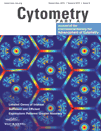
Experiment Overview
| Repository ID: | FR-FCM-ZZWG | Experiment name: | PTAA | MIFlowCyt score: | 60.39% |
| Primary researcher: | Marek Los | PI/manager: | Marek Los | Uploaded by: | Marek Los |
| Experiment dates: | 2012-11-25 - 2028-01-01 | Dataset uploaded: | Dec 2014 | Last updated: | Jan 2015 |
| Keywords: | [fluorescence] [fIbroblast] [Conjugated polyelectrolyte] [luminescent conjugated polythiophene] [melanoma] | Manuscripts: |
|
||
| Organizations: |
German Rheumatism Research Center Berlin, a Leibniz-Institute (DRFZ), Immunemonitoring, Berlin, (Germany)
|
||||
| Purpose: | In the manuscript we investigated the behavior of novel fluorescent dye polythiophene acetic acid (PTAA) in normal and transformed cells. PTAA appeared to enter fibroblasts through an association with fibronectin and subsequently end up partially localized to lysosomes after 24 h. The uptake and intracellular target in malignant melanoma cells was more ambiguous and the intracellular target of PTAA in transformed cells is still elusive. PTAA was well tolerated by both cell lines, and microscopic analysis as well as viability assays showed no signs of negative influence on growth. Stained cells maintained their proliferation rate for at least 12 generations. Although the probe itself was non-toxic, photo-induced cellular toxicity was observed in both cell lines upon light exposure of freshly stained cells. However, no cytotoxicity was detected when the cells were exposed to light 24 h after staining, indicating that the photo-induced toxicity is dependent on the cellular location of the probe. | ||||
| Conclusion: | Overall, these studies certified PTAA as a useful agent for vital staining of specific cells, and that PTAA can potentially be utilized to study cancer-related biological and pathological processes. | ||||
| Comments: | I really hate FlowRepository | ||||
| Funding: | Not disclosed | ||||
| Quality control: | ACCA | non-stained samples were used as controls | |||
